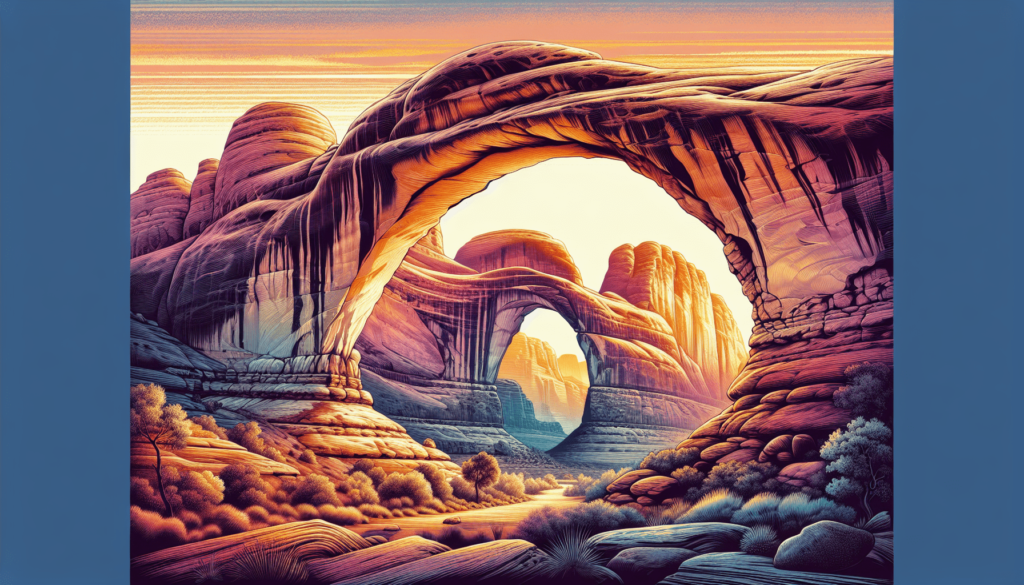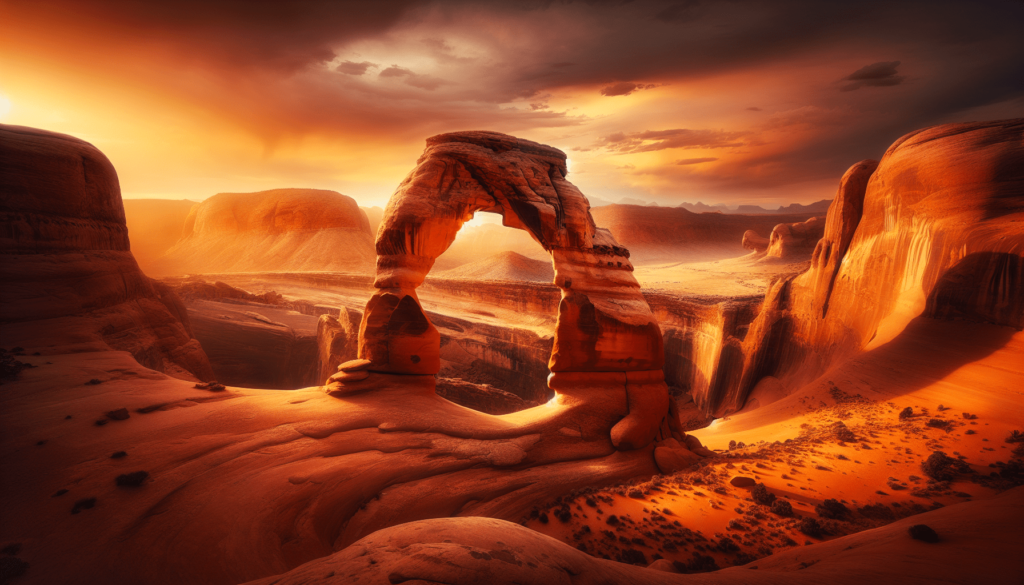Imagine embarking on an adventure to one of the most awe-inspiring natural wonders in the United States, nestled in the rugged terrain of Arizona. The Rainbow Bridge National Monument promises an unforgettable journey through breathtaking landscapes, leading you to the world’s largest natural bridge. Shaped by centuries of weathering and water erosion, this spectacular formation is not only a geological masterpiece but also a sacred site to several Native American tribes. Your exploration of Rainbow Bridge will be a journey through both the grandeur of nature and the profound depth of cultural heritage.

This image is property of images.pexels.com.
Overview of Rainbow Bridge National Monument
Location and Geography
Rainbow Bridge National Monument is a breathtaking natural wonder nestled in the rugged and scenic landscapes of southern Utah, near the Arizona border. This remote monument is surrounded by the red sandstone cliffs of Glen Canyon National Recreation Area, making its accessibility quite an adventure. The bridge is carved out by centuries of erosion and stands majestically above Bridge Creek. The geography around the monument is a blend of desert and rugged canyon terrains, offering spectacular views and immersive nature experiences.
Significance and Recognition
Rainbow Bridge is one of the world’s largest known natural bridges, a testament to the power of natural forces. Due to its extraordinary characteristics and cultural importance, it has been protected as a National Monument since 1910. The bridge holds deep spiritual significance for several Native American tribes, who view it as a sacred symbol in their cultural heritage. Its recognition extends beyond its physical grandeur; it’s celebrated for its profound cultural and ecological value.
Ecological and Cultural History
The ecological and cultural history of Rainbow Bridge is as rich and varied as its landscape. The area has been home to Native American tribes for thousands of years, each leaving their mark on the land. The surrounding ecosystems have adapted and thrived in the arid conditions, supporting a variety of plant and animal life that is both resilient and delicate. The monument’s history is a complex tapestry of natural evolution and human interaction, telling stories of survival, reverence, and exploration.
Geological Formation
Natural Arch Formation Process
The formation of Rainbow Bridge is a fascinating geological tale that spans millions of years. Initially, the region was near sea level and subjected to massive amounts of sediment deposition. Over time, through the processes of compaction and cementation, these sediments turned into the sandstone that comprises the bridge today. Erosion played the critical role in sculpting the bridge, primarily by water flowing through the creek, slowly carving out the arch from the surrounding rock.
Geological History of the Region
The geological history of the Rainbow Bridge region is characterized by dramatic shifts. From the rise and fall of ancient seas to the uplift of the Colorado Plateau, each epoch has contributed to the landscape’s current form. The layers of sandstone visible today tell a story of ancient environments, preserved in stone. This history is key to understanding not just the formation of Rainbow Bridge, but also the evolution of the entire surrounding area.
The Impact of Erosion and Weathering
Erosion and weathering are the primary forces that continue to shape Rainbow Bridge today. While the bridge is relatively stable, these processes are constant, gradually altering the monument’s appearance over time. The delicate balance of preservation and natural sculpting is a reminder of the monument’s vulnerability and the need for ongoing conservation efforts.
Cultural Importance
Native American Heritage and Beliefs
For numerous Native American tribes, including the Navajo, Hopi, and San Juan Southern Paiute, Rainbow Bridge is more than a geological wonder; it is a sacred symbol. These tribes have held beliefs and traditions connected to the bridge for generations, viewing it as a link between past and present, the earth and the sky. The monument’s significance goes beyond its physical presence, embodying stories, rituals, and a deep spiritual heritage.
Historical Explorations and Naming
The official discovery of Rainbow Bridge by non-Indigenous explorers occurred in the early 20th century. The name “Rainbow Bridge” was inspired by its resemblance to a rainbow, an apt description that captures the natural arch’s elegance and grandeur. This period also marked the beginning of the monument’s broader recognition and its eventual protection.
Preservation Efforts for Cultural Sites
Preservation of Rainbow Bridge and the surrounding area has been a concerted effort, balancing visitor access with the protection of its delicate ecosystems and cultural significance. Regulations and guidelines ensure that visitors respect the sacredness of the site, its natural beauty, and its historical artifacts. These efforts are crucial in safeguarding the monument for future generations.
Visiting Rainbow Bridge
How to Get There: Boat and Hiking Options
Accessing Rainbow Bridge requires a bit of adventure, with options to arrive by boat or on foot. Boat tours depart from Page, Arizona, traveling through the beautiful Lake Powell before reaching the monument. For those seeking a more challenging route, hiking paths offer a close-up experience of the rugged desert landscape. Both options provide unique perspectives and opportunities to witness the monument’s majesty.
Best Times to Visit
The best time to visit Rainbow Bridge is during the spring and fall months, when temperatures are more moderate, and the risk of flash floods is lower. These seasons offer the most comfortable conditions for exploring the monument and its surrounding environment.
Visitor Guidelines and Etiquette
When visiting Rainbow Bridge, it’s essential to follow guidelines designed to protect the monument and its sacred significance. Stay on designated paths, carry out all trash, and respect the cultural and natural landscapes. Remember, the monument is a revered site; treat it with the same respect you would a cathedral or temple.

This image is property of images.pexels.com.
Hiking to Rainbow Bridge
Trail Descriptions and Difficulty Levels
Hiking to Rainbow Bridge offers two main trails, each presenting different challenges and experiences. The trails wind through the desert, offering stunning views and immersive encounters with the area’s natural beauty. Hikers should assess their fitness level and prepare accordingly, as the routes can be strenuous and remote.
Safety Tips for Hikers
Safety is paramount when hiking in this remote area. Carry plenty of water, use sun protection, and let someone know your plans. Be aware of weather conditions, as flash floods can occur with little warning. Always stay on designated paths to minimize your impact on the environment and your risk of getting lost.
What to Bring: Essential Gear and Supplies
When hiking to Rainbow Bridge, essential gear includes water, food, sun protection, sturdy footwear, and a map. Additionally, consider a first-aid kit, a flashlight, and extra layers for changing conditions. Preparation is key to a safe and enjoyable experience.
Flora and Fauna
Native Plant Species
The area surrounding Rainbow Bridge supports a diverse array of plant life adapted to the desert environment. From flowering cacti to hardy shrubs, the flora here has evolved to thrive with minimal water. These plants not only contribute to the area’s natural beauty but also support local wildlife.
Wildlife Observation Opportunities
For those interested in wildlife, the monument area offers opportunities to observe animals in their natural habitat. Desert mammals, reptiles, and a wide variety of birds can be spotted, especially during the cooler parts of the day. Always observe wildlife from a distance and avoid disturbing their natural behaviors.
Conservation Efforts in the Area
Conservation efforts around Rainbow Bridge focus on protecting the fragile ecosystems and cultural sites from the impacts of tourism and climate change. Initiatives include habitat restoration, visitor education, and research projects aimed at understanding and mitigating threats to the monument’s integrity.

This image is property of images.pexels.com.
Photography Tips
Best Locations and Times for Photos
For photographers, the best times to capture Rainbow Bridge are early morning and late afternoon, when the light is soft and the colors of the rock and sky are most vibrant. The viewpoints along the trails offer stunning compositions, with the bridge itself being the focal point.
Photography Rules and Regulations
Photography at Rainbow Bridge is encouraged, but it’s important to follow specific rules and regulations. Drones are prohibited, as is the use of equipment that could damage the site or disrupt wildlife. Always stay on the path and respect the natural and cultural landscapes.
Creative Angles and Techniques
Exploring different angles and techniques can add depth to your photography. Incorporate elements of the surrounding landscape, experiment with lighting, or capture the monument against the night sky. The unique setting of Rainbow Bridge offers endless opportunities for creative expression.
Camping and Accommodation
Nearby Camping Sites
For those looking to extend their stay, several camping sites are located near Rainbow Bridge, both within Glen Canyon National Recreation Area and in the surrounding regions. These sites offer a range of facilities, from primitive to more developed options.
Lodging Alternatives
For a more comfortable stay, the nearby town of Page, Arizona, offers various lodging alternatives, including hotels, motels, and bed and breakfasts. Staying in Page also provides easy access to other attractions in the area.
Backcountry Camping: Rules and Recommendations
Backcountry camping offers an immersive way to experience the monument’s natural beauty. Permits are required, and campers must follow leave-no-trace principles to minimize their impact on the environment. Be prepared with adequate supplies, as these areas are remote and lack facilities.

Water Activities
Boating Near Rainbow Bridge
Boating on Lake Powell provides a scenic route to Rainbow Bridge, with boat rentals and guided tours available. This option offers a unique perspective of the monument and the surrounding landscape from the water.
Fishing Regulations and Opportunities
Fishing is a popular activity on Lake Powell, with regulations in place to ensure sustainable practices. Anglers can enjoy catching a variety of fish species, contributing to a memorable visit to the area.
Kayaking and Canoeing Information
Kayaking and canoeing are excellent ways to explore the quieter coves of Lake Powell and approach Rainbow Bridge at a leisurely pace. These activities offer a peaceful and environmentally friendly way to enjoy the monument’s stunning surroundings.
Conservation and Future Challenges
Threats to the Monument’s Integrity
The major threats to Rainbow Bridge’s integrity include the effects of climate change, increased tourism, and potential vandalism. These challenges require vigilant management and global awareness to ensure the monument’s preservation.
Current Conservation Measures
Current conservation efforts encompass a range of strategies, from visitor education and habitat protection to scientific research. These measures aim to safeguard the monument’s ecological balance and cultural significance for the future.
How Visitors Can Contribute to Preservation
As a visitor, you can contribute to the preservation of Rainbow Bridge by respecting the site, following all guidelines, and minimizing your environmental impact. Participating in conservation programs or supporting organizations dedicated to protecting the monument are also meaningful ways to help ensure its future.


